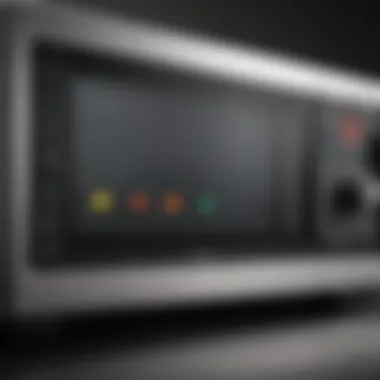Determining the Best Microwave: A Comprehensive Analysis


Intro
In the modern kitchen, the microwave is more than just a tool for reheating leftovers. It represents a blend of convenience, efficiency, and innovation. Understanding the nuances of various microwaves can significantly enhance culinary practices and daily meal preparation. This article sets out to evaluate the essential characteristics that define the optimal microwave, focusing on its performance, features, and user needs.
The landscape of microwaves has evolved tremendously over the years. From traditional countertop models to built-in units, the choice is vast and often overwhelming. Consumers today are not only looking for functionality but also for designs that harmonize with the aesthetics of their kitchens.
Additionally, one must consider dimensions, wattage, and unique functionalities such as convection cooking, grilling options, and sensor cooking. Each of these aspects contributes to the overall efficiency and satisfaction derived from the appliance. By comprehensively analyzing these components, this piece aims to empower readers to select microwaves that align with their culinary aspirations and practical requirements.
Key Consideration: Selecting a microwave is not merely about brand preference but understanding how specific features cater to individual cooking styles.
To navigate the decision-making process, the following sections will dissect microwave types, delve into their specific functionalities, and highlight key innovations shaping the industry. This analysis promises to elevate the reader’s comprehension of microwave technology, leading to more informed purchases in the future.
Prelude to Microwave Ovens
Microwave ovens have become an essential appliance in many kitchens worldwide. Their convenience and efficiency in cooking have made them a popular choice among individuals and families alike. The importance of exploring the topic of microwave ovens lies in understanding their technology, features, and impact on our cooking practices. In this article, we seek to dissect various elements related to microwaves to aid readers in making informed choices.
To begin with, one must appreciate what microwave technology involves. This includes an overview of how it works and what makes it distinct from other cooking methods. Since these appliances vary significantly in design and function, knowing what is available in the market can empower consumers. Purchasing a microwave should not be a mere decision but rather an informed choice influenced by specific needs and preferences.
Choosing the right microwave can influence not only cooking efficiency but also kitchen aesthetics. It can enhance culinary experiences, streamline food preparation, and even save time during busy schedules. Such considerations underscore the importance of understanding microwave ovens comprehensively. Let's delve deeper into the nuances of microwave technology.
Overview of Microwave Technology
Microwave technology operates on principles involving electromagnetic radiation. Microwaves are a form of radio wave that stimulates the water molecules in food. When these molecules agitate, they produce heat, which cooks the food. This method is different from traditional cooking that typically relies on direct heat sources.
The efficiency of microwave cooking comes from its ability to heat food quickly. Most home microwaves function in the range of 900 to 1200 watts, though commercial units can operate at higher power. Power output directly affects cooking times and food quality, which makes it a critical point to consider.
Some microwaves also incorporate advanced technologies. For instance, inverter technology allows for more even cooking by extending cooking times at lower power levels. This feature can be especially beneficial for delicate tasks like defrosting and reheating.
Significance of Choosing the Right Microwave
Selecting the right microwave is a multi-faceted decision that involves weighing various factors.
- Cooking Needs: Understanding your cooking habits is essential. Do you primarily reheat food, or do you prepare complex meals? This influences the size and type of microwave needed.
- Space Considerations: The dimensions of your kitchen and available counter space can limit options. Countertop models differ from built-in designs. An oversized model may disrupt the kitchen layout.
- Aesthetic Choices: Microwaves come in various styles and finishes. Match the appliance to your kitchen's decor for a cohesive look.
- Functional Features: Different models offer diverse functions, from auto-cook settings to specialized modes for popcorn or pizza.
Ultimately, choosing the right microwave enhances not just your cooking but your overall kitchen experience. Taking the time to assess personal needs will yield a more satisfying purchase.
"The perfect microwave is not defined by its features alone but how well it aligns with an individual's cooking practices."
In summary, understanding microwave ovens involves diverse considerations spanning technology, types, and individual needs. By recognizing the significance of these factors, consumers can make informed decisions that elevate their cooking experiences.
Types of Microwaves Available
When deciding on the right microwave for your kitchen, understanding the different types of microwaves available is crucial. Each type has unique features, benefits, and limitations that cater to varying culinary needs and kitchen layouts. This section will explore the primary categories of microwaves to help you determine which might be the best fit for your lifestyle.
Countertop Microwaves
Countertop microwaves are perhaps the most popular choice among consumers. They are versatile, affordable, and easy to install. These microwaves can be placed on any flat surface in the kitchen, making them a convenient option for those with limited space.
They come in various sizes and power ratings, typically ranging from 600 to 1200 watts. Higher power generally means faster cooking and more even heating, a vital factor for reheating leftovers or cooking a meal from scratch. Their design allows for substantial interior space, accommodating larger dishes, which is an advantage for families or those who frequently cook larger portions.
Countertop models feature various preset cooking options, helping users achieve consistent results. Some advanced versions even include sensor cooking technology that automatically adjusts cooking times and power levels. However, they do require counter space, which may be a disadvantage for smaller kitchens.


Over-the-Range Microwaves
Over-the-range microwaves are particularly advantageous for those looking to maximize kitchen space. This style combines a microwave with a range hood, providing both cooking and ventilation functions. They are installed above the stove, freeing up valuable counter space.
Not only do these microwaves serve a functional purpose, but they often come equipped with additional features such as lights and exhaust fans. Proper ventilation helps improve air quality in the kitchen by removing smoke and odors. The combination of these functions also means that users gain a more streamlined appearance and efficiency in their kitchen design.
However, potential drawbacks exist. Over-the-range microwaves typically have a smaller cooking capacity compared to countertop models. Installation might also require professional assistance, adding to the overall cost. Moreover, their positioning can vary depending on kitchen height, which must be carefully considered to ensure usability.
Built-In Microwaves
Built-in microwaves are designed for those who prefer a seamless, integrated look in their kitchen. These appliances are installed directly into kitchen cabinetry or walls, creating a custom appearance that can enhance any kitchen layout. This may come with a higher price tag, but the aesthetic appeal and convenience can justify the cost.
Built-in models provide a variety of features similar to other types of microwaves. These include sensor cooking, convection options, and larger capacities. They often sit at a comfortable height for cooking and accessing food, reducing strain. However, the installation process can be complex and may require professional help, leading to additional expenses.
Microwave Ovens with Convection Features
Microwave ovens with convection features combine the rapid cooking of microwaves with traditional convection heating. This dual functionality allows for browning, crisping, and cooking foods evenly. The convection fan circulates hot air around the food, achieving similar results to that of conventional ovens but in a fraction of the time.
This type of microwave is ideal for those who enjoy versatility and often prepare various dishes. It serves not only for reheating but also for baking and roasting, making it suitable for a wide range of recipes. Moreover, the time efficiency can be a significant advantage for busy individuals or families.
One factor to consider with convection microwaves is the price, as they tend to be more expensive than standard models. Additionally, they require more energy than traditional microwaves, which may influence decision-making for those focused on energy consumption.
"Selecting the right microwave type affects not only space utilization but also cooking outcomes crucial for daily meal preparations."
Key Features to Consider
Selecting a microwave oven is not simply about brand or aesthetic appeal. It involves understanding various features that significantly affect performance and usability. Key features help in determining how well a microwave meets specific cooking needs. A thoughtful approach towards these elements can lead to enhanced cooking efficiency and better meal preparation overall.
Power Output and Cooking Efficiency
Power output is a critical aspect of any microwave. Measured in watts, it influences both cooking times and the efficiency of the heating process. Most average microwaves range from 600 to 1200 watts. Higher wattage results in faster cooking times while ensuring more even heating. This becomes crucial when preparing larger dishes or working with denser materials.
For instance, a microwave with 1000 watts may heat food more efficiently than a 700-watt model, reducing overall cooking time. Consideration of cooking efficiency often ties to power output, especially for those who frequently prepare food using a microwave. Choosing a model that aligns with your cooking habits can not only enhance meal preparation but also save energy over time.
Size and Capacity
Size and capacity of a microwave must align with your kitchen space and cooking needs. Microwaves come in various sizes, from compact options to larger, family-sized models. A small countertop microwave takes less space, making it suitable for kitchens with limited counter area.
However, if you regularly cook for a family or need to reheat multiple items, a larger capacity might be more suitable. Measuring interior dimensions is important. It is essential to understand not just the exterior size but also how much space is available inside. Factors like turntable size and overall design can affect how well you can utilize the interior space.
Control Options and User Interface
User interface and control options have become significant in microwave design. Modern microwaves now feature sensor cooking, programmable settings, and easier-to-read displays. This makes it more straightforward for users to navigate the functionalities of their microwave.
Many users prefer intuitive controls that do not require extensive manuals. Touchpad controls often allow for easy setting adjustments compared to knob-based controls. A well-designed interface can save time and effort, especially when quickly adjusting power levels or cooking times.
Safety Features
Safety features in microwaves are paramount. Many models now come equipped with options like child locks, automatic shutoff, and thermal protection. These features are not just added conveniences; they play a critical role in preventing accidents.
A microwave that includes a child lock can protect younger family members from accidental use, while automatic shutoff features ensure that the appliance does not overheat during cooking. Understanding and prioritizing safety features will lead to more responsible microwave use, which is especially important in a family setting.
Comparing Microwave Brands


In the realm of kitchen appliances, the choice of microwave can greatly influence both daily cooking experiences and long-term meal preparations. Therefore, comparing microwave brands is crucial. Not all microwaves are created equal, and brands differ in terms of quality, reliability, and features. An informed choice requires an understanding of what each brand brings to the table.
Different brands have distinct reputations and cater to various needs. Some may focus on advanced technology, while others prioritize affordability. Understanding these differences aids consumers in selecting a microwave that aligns with their cooking habits and lifestyle.
Top-Rated Brands Overview
When discussing the best microwave brands, some consistently rise above the rest. Brands like Panasonic, Breville, and Samsung often earn praise for their innovation and durability. Their products typically showcase advanced features, high performance, and user-friendly controls. Additionally, Sharp and LG also have a dedicated following among consumers due to their design and efficient cooking capabilities. Each brand has its strengths, making it necessary to evaluate what consumers truly need.
Brand Comparisons: Features and Performance
In comparing microwaves, several factors need consideration. Power output is one of them. Higher wattage typically means quicker cooking times and better heating efficiency. For instance, a Panasonic microwave often boasts inverter technology that provides consistent power. This feature is significant for tasks like defrosting or reheating leftovers.
Size and design also play critical roles. Some brands like Whirlpool provide compact models that fit easily in smaller kitchens, whereas larger brands like LG offer spacious units that are ideal for bigger households. Similarly, user interface differs, where brands such as Breville focus on intuitive controls, making them user-friendly.
User Reviews and Feedback
User feedback provides real-world insights. By exploring platforms like Reddit and consumer review sites, potential buyers can gauge common issues and admirations. Typically, reviews highlight aspects such as reliability, ease of use, and customer service. Consumers frequently emphasize the importance of warranty support following purchase, influencing their brand allegiance.
User reviews often reveal sentiment around design and functionality—an attractive microwave that performs well undoubtedly enhances the kitchen's aesthetic. Moreover, sturdy construction and an even cooking performance are often valued by users, influencing their overall satisfaction.
"Microwaves are not just appliances; they are important kitchen partners that help streamline daily cooking tasks."
The Role of Microwaves in Cooking
Understanding the role of microwaves in cooking is crucial for selecting the right appliance. Microwaves are not just about reheating leftovers. They serve various functions in the kitchen, enhancing convenience and efficiency. This section will cover two main aspects: the practicality of microwaves for reheating and defrosting and their innovative uses in cooking.
Microwaves for Reheating and Defrosting
Reheating food using a microwave is one of its most valued functions. The quick heating process makes it ideal for busy lifestyles. Here are some benefits of using microwaves for these tasks:
- Time-saving: Microwaves cook food faster than conventional ovens. You can reheat meals in just a few minutes.
- Energy-efficient: Since they use less power than traditional ovens, microwaves can save energy when reheating smaller portions.
- Retention of moisture: Microwaves heat food from within, which helps maintain moisture. This is especially useful for items like casseroles and soups, preventing them from drying out.
Defrosting is another critical function of microwaves. The appliance can quickly thaw meats or frozen dishes, making it a convenient choice when time is short. However, there are some considerations:
- Uneven thawing: Sometimes, microwaves can heat unevenly, leading to partially cooked edges while other areas are still frozen. It is best to cook immediately after defrosting to avoid bacteria growth.
- Proper containers: Use microwave-safe containers to ensure safety and proper heating.
Innovative Cooking Techniques Using Microwaves
Microwaves offer more than reheating and defrosting. Many innovative cooking techniques can elevate your culinary skills. Here are some methods worth exploring:
- Steaming: Using a microwave-safe bowl with a lid, you can steam vegetables quickly without losing nutrients.
- Baking: Certain microwave models have convection features, allowing you to bake small batches of cakes and muffins. This is highly advantageous when you don’t want to heat up the entire kitchen with a traditional oven.
- Cooking Grains: Microwaves can cook rice and other grains effectively. Just add water and let the microwave do the work.
- Cooking Fish: Steaming fish in the microwave can keep it moist and flavorful. You can add herbs or spices for extra taste without much hassle.
- Making Snacks: It’s possible to create popcorn or even mug cakes using just a microwave. These quick treats require minimal ingredients and time.
"Microwaves redefine convenience in cooking, enabling users to adopt efficient methods while enjoying diverse culinary experiences."
The versatility of microwaves in modern kitchen practices cannot be overstated. By employing these techniques, you can enhance your everyday cooking while maximizing the appliance's potential.
Energy Efficiency and Economic Considerations
Energy efficiency is a critical factor when selecting a microwave. Consumers increasingly seek to balance functionality with economic viability. Choosing an energy-efficient microwave not only minimizes the immediate costs on electricity bills but also contributes positively to the environment. Understanding this aspect can help consumers make informed decisions that align with both financial and ecological interests.
Moreover, energy-efficient models are designed to use the least amount of power while maximizing performance. This results in reduced energy consumption without sacrificing cooking quality or speed. In the long run, opting for a model with higher efficiency ratings can prove to be a financially sound choice.
Energy Consumption Ratings


Energy consumption ratings are essential metrics that allow buyers to compare the efficiency of different microwave ovens. These ratings are usually presented in kilowatt-hours (kWh) and indicate how much energy a unit will likely consume during operation. The higher the rating, the less energy the microwave uses per cooking cycle.
When examining energy consumption ratings, it is beneficial to look for the ENERGY STAR label. Microwaves bearing this label meet strict energy efficiency guidelines set by the U.S. Environmental Protection Agency. Consumers should prioritize these models as they often save more energy compared to standard models.
Here are some points to consider:
- Understanding Usage: Being aware of typical cooking habits can help determine what energy consumption is reasonable for a household.
- Size Matters: Larger microwaves might consume more energy, so it is important to select a size that meets your needs without excess.
- Features Impacting Consumption: Functions like sensor cooking can optimize cooking times and minimize wasted energy.
Long-term Cost Savings
The long-term cost savings associated with an energy-efficient microwave extend beyond just lower power bills. Investing in a higher-efficiency model can lead to numerous financial benefits over time. Here’s how:
- Decreased Energy Bills: More efficient microwaves generally consume less power, translating to reduced monthly utility expenses.
- Improved Cooking Times: Many energy-efficient microwaves utilize advanced technologies that can speed up cooking processes. This efficiency means food can be prepared faster, leading to lower overall energy use.
- Less Frequent Replacement: Energy-efficient models are typically built with longevity in mind, reducing the need for frequent replacements.
In addition to the above points, using an energy-efficient microwave contributes to sustainability. Lower energy use lowers the carbon footprint of a household, which is a significant consideration for environmentally conscious consumers.
Investing in an energy-efficient microwave today leads to financial savings and a positive impact on the environment tomorrow.
Frequently Asked Questions about Microwaves
Understanding common queries related to microwaves can significantly enhance the buying experience for consumers. This section delves into popular questions that users frequently have, particularly regarding the functioning, maintenance, and troubleshooting of microwave ovens.
Knowing the answers can help both novice and experienced buyers make informed choices and ensure their appliances serve well over time. This knowledge is fundamental, not just for troubleshooting, but also for optimizing microwave use and maintenance.
Common Microwave Issues and Solutions
Many users encounter issues with their microwaves at some point. Here are some common problems and their solutions:
- Microwave Not Turning On: If the microwave fails to start, check if it is plugged in and that the outlet functions properly. Also, examine the door latch; a faulty latch can prevent operation.
- Uneven Heating: This can occur because of the position of food within the microwave. Ensure to arrange food evenly on the turntable or use an appropriate microwave-safe cookware for better heat distribution.
- Strange Noises: Occasional humming is normal, but if there are loud noises, it may indicate a problem with the fan or motor. Inspecting for any obstructions may resolve the issue.
- Burnt Smells: This issue can happen due to food spills inside the microwave. Regularly clean the interior to avoid residue buildup which can result in unpleasant odors.
"By understanding common problems, users can extend the life of their microwaves and maintain functionality."
Best Practices for Microwave Maintenance
Proper maintenance is crucial to ensure the longevity and efficiency of microwave ovens. Follow these practices for optimal performance:
- Regular Cleaning: Wipe the interior and exterior with a damp cloth to remove food particles and grease. Using a gentle cleanser can help maintain the appliance's appearance.
- Inspect the Door Seal: Regularly check the rubber seal around the door. A worn or damaged seal can lead to energy loss and inefficient heating.
- Avoid Overloading: Do not exceed the design capacity of your microwave. Overloading can lead to overheating and damage.
- Use Microwave-Safe Containers: Only utilize containers labeled as microwave-safe. This prevents leaching harmful chemicals into food and ensures safe heating.
- Perform Periodic Checks: A routine examination of essential components such as the turntable and ventilation system can help identify potential issues before they escalate.
By incorporating these maintenance routines, users can enhance the effectiveness of their microwave ovens and enjoy hassle-free cooking.
The End: Making the Right Choice
In this article, we have examined the various aspects of microwaves that influence a consumer’s choice. The significance of making an informed decision cannot be overstated. Choosing the right microwave involves understanding personal needs, kitchen space, and functionality. Not all microwaves are created equal; therefore, it is crucial to consider features such as power output, capacity, and available settings when selecting an option. Additionally, the longevity and reliability of the appliance can affect its value over time.
Another vital element is aligning the microwave's capabilities with your culinary practices. If your primary use is reheating simple meals, a basic model may suffice. However, for those who want to explore culinary innovation, like convection cooking, more advanced options are warranted. Taking the time to analyze features and match them with intended use greatly enhances satisfaction with your purchase.
Summarizing Key Points
- Understanding types of microwaves: Recognizing the difference between countertop, over-the-range, and built-in models is fundamental.
- Key features: Focus on power output, size, control options, and safety features to find the right fit.
- Brand reputation: Informed choices often stem from reviews and comparisons of trusted brands in the market.
- Practical implications: Reflect on energy efficiency and the potential long-term savings associated with various models.
"A well-chosen microwave can enhance not just meal preparation but also overall kitchen efficiency."
Final Recommendations Based on Use Case
For those who frequently cook or experiment with recipes, a microwave with convection options can be beneficial. This will provide versatility beyond simple reheating. On the other hand, minimalists or those who primarily reheat might consider a compact countertop model which fulfills basic requirements without added complexity.
If energy efficiency is a priority, choose models with an energy star rating. This choice promotes sustainable usage while potentially reducing electricity bills.
Ultimately, it is important to assess personal cooking habits, kitchen dimension, and budget constraints. Every user's experience and requirement differ, which is why a tailored approach to selection is necessary. Embracing the knowledge shared in this article will facilitate a fulfilling choice in your microwave.







